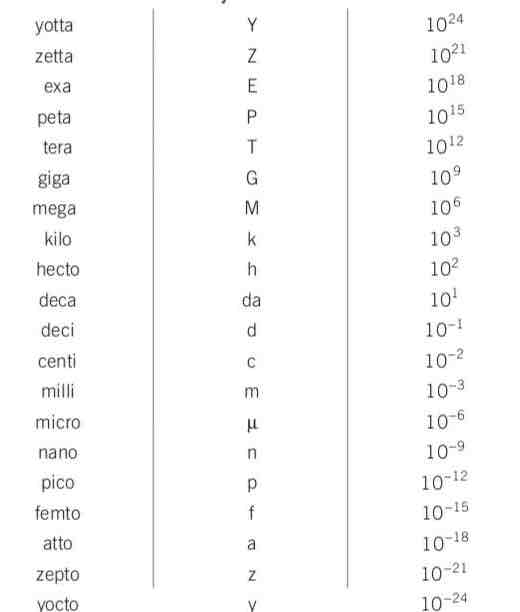units and measurements
PHYSICAL QUANTITIES
quantities which can be measured. they are of two types;
fundamental quantities: independent of other quantities. there are 7 fundamental quantities;
length, metre (m)
mass, kilogram (kg)
time, second (s)
electric current, ampere (A)
thermodynamic temp., kelvin (K)
amt. of substance, mole (mol)
luminous intensity, candela (cd)
derived quantities: derived from the fundamental quantities by multiplication/ division. eg: velocity = length/ time
to measure physical quantities, we need two things;
the unit, u
the numerical value/ magnitude, n
this gives us,
Q = nu
we know that the magnitude of a quantity remains same, no matter the unit of measurement
eg: 1 kg = 1000g
hence,
Q = n1u1 = n2u2
some common systems of units
FPS system: foot/ pound/ second
CGS system: centimeter/ gram/ second
MKS system: metre/ kilogram/ second
SI system: metre/ kilogram/ second
NOTE: the FPS system is not a metric system
order of magnitude: expression of very large numbers in the form N x 10^n where N < 10 (eg: 6.4 × 10^7)
prefixes of powers of 10

SIGNIFICANT FIGURES
a result of measurement includes all digits of the number known reliably plus one which is uncertain. these digits are called significant figures
eg: 374.5m has 4 SFs; 3,7 and 4 are certain while 5 is uncertain
rules to determine no. of SFs
all non-zero digits are significant (eg: 1234 → 4 SFs)
all zeros between 2 non-zero digits are significant (eg: 1007 & 10.07 → 4 SFs)
any zeros before the first non-zero digit is not significant (eg: 0.005704 → 4 SFs)
trailing zeros are not significant in non-decimal no.s (eg: 3210 → 3 SFs)
trailing zeros are significant in decimal no.s (eg: 3.500 → 4 SFs)
multiplying/ dividing factors have infinite no. of SFs (eg: in r = d/2, 2 → infinite SFs)
the no. of SFs do not depend on the unit (eg: 16.4cm, 0.164m and 0.000164cm → all have 3 SFs)
rounding off measurements
to round off measurements, the following rules must be followed;
if the digit is less than 5, it is dropped (eg: 7.82 → 7.8)
if the digit is more than 5, it is dropped & the preceding digit is raised by 1 (eg: 6.87 → 6.9)
if the digit is 5 followed by any non-zero digit, they are both dropped and the preceding digit is raised by 1 (eg: 16.351 → 16.4)
if the digit is 5 followed by 0, it is dropped and the preceding digit is left unchanged (eg: 3.250 → 3.2)
rules for operations with SFs
addition & subtraction: the final result should retain as many decimal places as there are in the number with the least decimal places (eg: 2.1m + 1.78m + 2.046m = 5.926m → 5.9m
multiplication & division: the final result should retain as many SFs as there are in the number with the least SFs (eg: 3.00 × 3.155 = 9.4685 → 9.46 → 9.5 (rounded off))
least count
it is the smallest subdivision on a scale and it is uncertain while measuring (eg: in a cm scale, 1mm is smallest subdivision)
least count of a screw gauge = pitch/ total no. of divisions
NOTE
precision: closeness of two measurements to each other
accuracy: closeness of a measurement to the actual value
DIMENSIONS OF A PHYSICAL QUANTITY
they are the powers to which the units of base quantities are raised to represent a derived unit
as we know, there are 7 base quantities, [L], [M], [T], [A], [K], [Cd] & [mol]
eg: V = [L] x [L] x [L] = [L]³ = [M^0L³T^0]
F = ma = [M] x [L]/[T]² = [M^1L^1T^-2]
the above are called dimensional formulae of a quantity
easy strategy to find dimensional formulae
write the formula of the quantity (eg: a = velocity/ time)
convert it into fundamental quantities (eg: a = length/ time²)
write the symbols for the fundamental quantities (eg: length/ time² = L/T²]
convert it into the form [MLT] (eg: L/T² = [M^0L^1T^-2])
DIMENSIONAL ANALYSIS
dimensional analysis helps us to find relations between different physical quantities. it has 3 uses;
checking the dimensional consistency of equations: the principle of homogeneity of dimension: all terms in a physical quantity equation must have same dimensions (a dimensionally correct equation)
eg: s = ut + ½ at²
here, [L] = [L] + [L]
conversion of units from one system to another: we know,
Q = n1u1 = n2u2
which gives,
n2 = n1u1/u2 (where u1 & u2 are 2 units and n1 and n2 are their respective numerical values)
if u1 has dimensional formula [M1^aL1^bT1^c] and u2 has [M2^aL2^bT2^c], then we get,
n2 = n1 [M1^aL1^bT1^c]/ [M2^aL2^bT2^c]
hence,
n2 = n1[M1/M2]^a [L1/L2]^b [T1/T2]^c
ex Q: find the value of 60J per min on a system that has 100g, 100cm and 1 min as the base units
=> 60J/ 1 min = 60J/60s = 1W
dimensional formula of P = [ML²T^-3]
n1 = 1, M1 = 1000g, L1 = 100cm, T1 = 1s, n2 = ?, M1 = 100g, L2 = 100cm, T2 = 60s
n2 = 1[1000/100]^1 [100/100]² [1/60]^-3
= 2.16 × 10^6
deducing relation among physical quantities: we can find the dependence of a physical quantity on other quantities
given by, Q = kq1^aq2^bq3^c
eg : consider a simple pendulum with a bob that oscillates under gravity. its t depends on mass, length & gravity
time period T = km^aL^bg^c (k = dimensionless constant of proportionality)
[M^0L^0T] = M^aL^b[LT^-2]^c
= [M]^a[L]b+c[T]^-2c
applying principle of homogeneity, a = 0, b = ½ & c = -1/2
substituting these values,
T = km^0l^1/2g^-1/2
T = k root l/g
NOTE: there are many limitations to dimensional analysis. it does not tell us if a quantity is scalar/ vector, and we cannot derive formulas with trigonometrical/ logarithmic functions